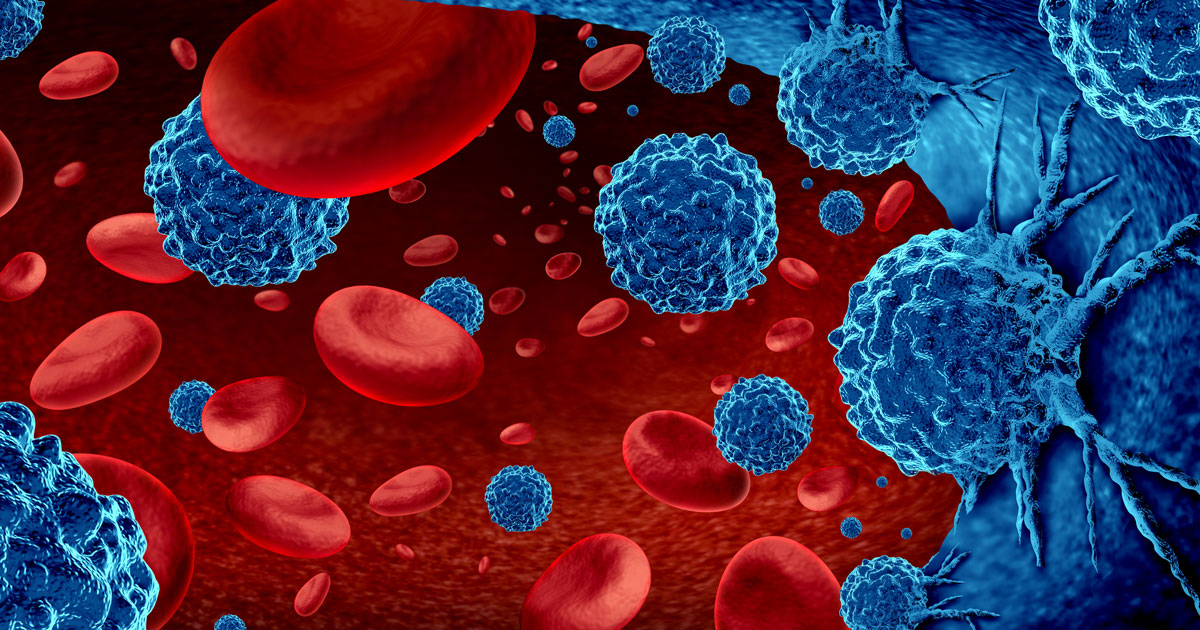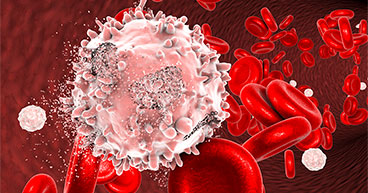
Trying to understand the different names and acronyms associated with leukemia may be confusing and intimidating. ALL? CML? CLL? And making sense of the different types of leukemia may seem as random as picking letters from a bag of Scrabble tiles. If this sounds familiar, this blog is intended to help clear up some of the confusion, especially given how pervasive leukemia can be.
The disease is the 11th most common cancer diagnosed in the United States, but it’s not always fully understood, perhaps due to the alphabet soup of acronyms for its various types and confusing terms like lymphocytes and myeloid cells. But as with many cancers, tiny details—even a single word or letter in its name—may make a dramatic difference in a patient’s prognosis.
In this blog, we’ll attempt to demystify leukemia and answer common questions about the disease, including:
- What is leukemia?
- What’s the difference between acute and chronic leukemias?
- What’s the difference between lymphocytic and myeloid leukemias?
- What’s chronic myeloid leukemia (CML)?
- What’s chronic lymphocytic leukemia (CLL)?
- How is leukemia treated at Cancer Treatment Centers of America® (CTCA)?
If you’ve been diagnosed with leukemia and have questions about your treatment plan, or you’re interested in a second opinion on your leukemia diagnosis, call us or chat online with a member of our team.
What is leukemia?
Leukemia is an umbrella term for cancer in the blood. It develops when abnormal white blood cells proliferate in the bloodstream, crowding out healthy white blood cells, red blood cells and platelets. Each of these cell types serves different, and important, functions to keep the body healthy. They are:
Erythrocytes: Red blood cells that carry oxygen from the lungs to organs and tissues
Leukocytes: White blood cells critical to the body’s ability to fight infection
Thrombocytes: Platelets that help the blood to clot, which in turn helps stop bleeding
As leukemic blood cells grow and spread, they disrupt the production of healthy blood cells, which may weaken the immune system and increase the risk of infection. Leukemia cells also circulate throughout the bloodstream and may affect the function of other organs, particularly the spleen, liver and lymph nodes.
Acute vs. chronic
When it comes to a leukemia diagnosis, one word may make the difference between a chronic disease that may not need immediate care and an acute form of the disease that requires aggressive treatment.
Leukemias are classified as acute or chronic depending on how slowly or quickly the leukemia cells grow and spread. In acute leukemias, the abnormal blood cells spread quickly and the patient will likely require immediate treatment. With chronic leukemias, the abnormal cells grow and spread slowly and the patient may not need treatment for years.
Lymphocytic vs. myeloid
Another important distinction is whether leukemia is classified as lymphocytic or myeloid.
Lymphocytes are types of white blood cells that form in the bone marrow—the spongy tissue in the middle of the bone—that help the body’s immune system function properly. The two primary lymphocytes are B-cells and T-cells. B-cells produce protective antibodies that stave off bacteria, virus, fungus and other toxins that enter the body, while T-cells help other white blood cells target and destroy bacteria, viruses and parasites. When leukemia blood cells develop in the lymphocytes, the disease that develops is known as lymphocytic leukemia.
Myeloid cells are a group of cells that mature into various adult blood cells. Myeloid cells include:
- Basophils, white blood cells that protect the body from infection and help with allergies and inflammation
- Neutrophils, white blood cells that serve as the first line of defense against bacterial and fungal infections
- Eosinophils, white blood cells that help fight infection and aid the immune system in fighting infections
- Monocytes, white blood cells that boost immune function and help with healing and inflammation
Myeloid leukemia is diagnosed when the leukemia cells are produced in myeloid cells.
What is chronic myeloid leukemia (CML)
Also known as chronic myelogenous leukemia, chronic myeloid leukemia (CML) develops when a piece of chromosome trades places with a piece from another, a process called translocation. In this case, a piece of chromosome 9 breaks off and attaches to chromosome 22, forming an abnormal gene called BCR-ABL. The altered chromosome 22 is known as the Philadelphia Chromosome.
As they multiply, CML cells eventually overflow from the bone marrow into the blood and may gather in organs, especially the spleen.
Compared to acute myeloid leukemia (AML), CML cells grow much more slowly. CML cells may eventually transform into fast-growing cells, changing the CML diagnosis to an AML diagnosis and making the disease more challenging to treat.
Risk factors and symptoms
Known risk factors for this disease, which is not believed to be hereditary, are age, gender (males are more commonly diagnosed) and exposure to high-dose radiation.
Symptoms of CML are somewhat generic and mimic those of other illnesses and diseases. They include:
- Fatigue
- Night sweats
- Unexplained weight loss
- Low-grade fevers
- Anemia
- Enlarged lymph nodes, especially in the neck
- Pain or full feeling
- Enlarged spleen
- Infections of the skin, kidney, lung or elsewhere
- Shortness of breath
No screening tests currently exist for CML, which accounts for about 15 percent of leukemias. Routine blood work, though, may show an elevated white blood cell count, which may prompt the doctor to order further testing, including a bone marrow biopsy. The average age at diagnosis is 64, though nearly half of CML patients are 65 or older when diagnosed.
Treating CML
Researchers have made great strides in both diagnosing and treating CML, particularly over the past decade. While the disease was once known to progress within months to years of being diagnosed, it’s now “almost cured,” according to a February 2021 article published in Cure Today, thanks to the many targeted therapy drugs approved to treat the disease.
What is chronic lymphocytic leukemia (CLL)
Chronic lymphocytic leukemia is the most common type of adult leukemia, accounting for one-quarter of new diagnoses. With CLL, white blood cells called lymphocytes don’t fully develop. In some cases, CLL may progress so slowly that patients may live for years before the leukemia cells proliferate enough to affect their health. The disease has been linked to mutations in chromosomes 11, 13 and 17.
CLL symptoms and risk factors
Many CLL patients do not experience symptoms until years after their diagnosis. Common symptoms that may develop include:
- Night sweats
- Unexplained weight loss
- Low-grade fevers
- General fatigue
Less common symptoms include:
- Bone pain
- Easily bruising or bleeding
- Swollen lymph nodes under the arm, neck or groin
- Swollen abdomen
In addition to blood tests, the pathologist may need bone marrow and lymph node biopsies to accurately diagnose CLL. Because CLL has a number of subtypes, the pathologist may need to perform multiple tests to help the care team determine an appropriate course of treatment.
CLL is typically considered an older person’s disease, since the average age at diagnosis is about 70. Men are at a slightly higher risk than women. But recent research has suggested a genetic predisposition for CLL, with increased odds for those who have first-degree relatives, particularly a sibling, diagnosed with the disease.
In addition to age, gender and family history, other CLL risk factors include:
- Race (it’s more common in white people)
- Exposure to chemicals such as herbicides and insecticides
It’s rare for CLL to develop into ALL.
Treating CLL
Doctors may not recommend treatment for CLL until the patient experiences significant symptoms such as an enlarged spleen, low blood counts or swollen lymph nodes. Until then, the oncologist may recommend a “watch and wait” approach, also known as “active surveillance,” during which doctors monitor patients over time for signs that the cancer has progressed.
The five-year survival rate for CLL is 88 percent, according to the National Cancer Institute. In May, the online medical journal OncLive.com reported that treating certain CLL populations with a combination of the drugs venetoclax and ibrutinib “has the potential to eradicate residual disease in patients with CLL.”
Treating leukemia at CTCA
Leukemia is a complex disease, so each patient’s prognosis and treatment plan varies. That’s why it’s important to consult an experienced team of doctors and clinicians trained to accurately diagnose the disease so you can make more informed decisions about your treatment plan.
At CTCA®, our medical oncologists, pathologists, hematologists, hematologist-oncologists and other blood cancer experts have years of experience diagnosing and treating various types and sub-types of leukemia. The oncologists at CTCA treat leukemia with standard-of-care and evidence-based treatments and technology, including:
Our care model is also designed to support patients throughout their treatment journey with supportive care services to help manage side effects, such fatigue, weight loss and pain.
If you’ve been diagnosed with leukemia and have questions about your treatment plan, or you’re interested in a second opinion on your leukemia diagnosis, call us or chat online with a member of our team.


